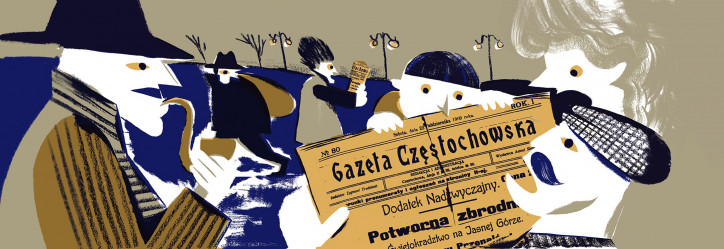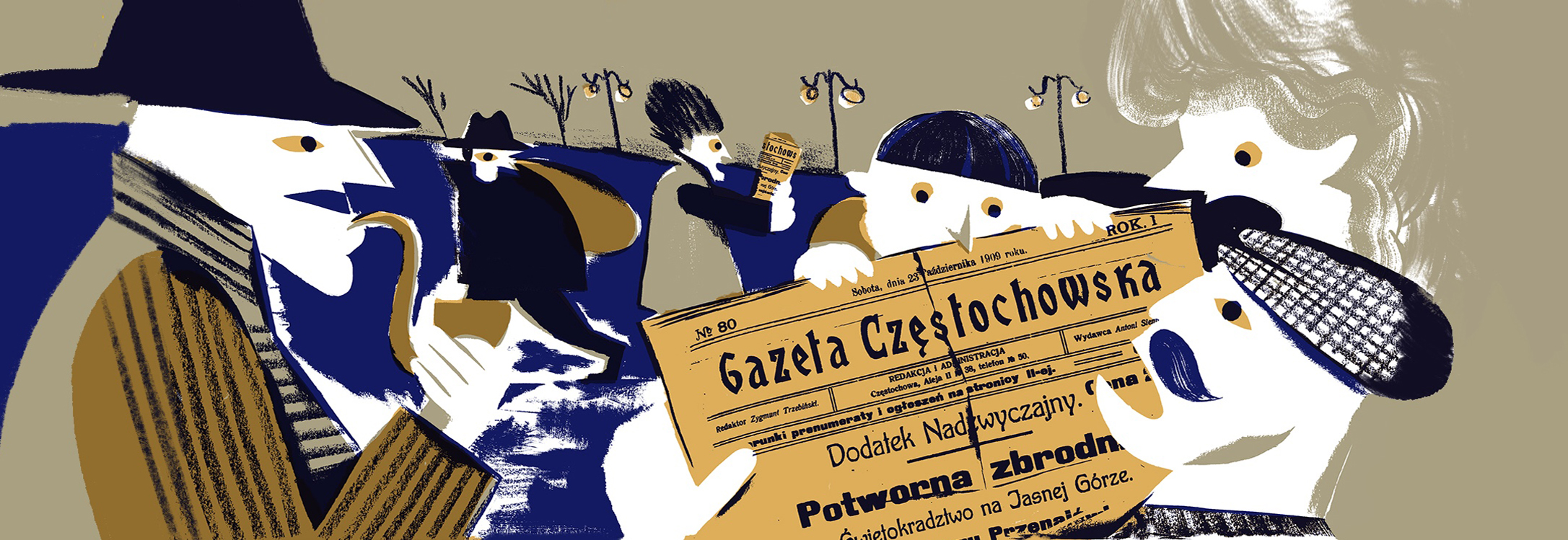
Four necklaces made of huge pearls strung on thick silver threads and presented as votive offerings. Four enamelled gold Virtuti Militari crosses. A five-kilogram gold leg. And above all, two solid-gold papal crowns with diamonds and pearl-encrusted dress, which were decorations made especially for the Black Madonna icon. According to press reports from 110 years ago, the thieves who broke into the Jasna Góra Monastery chapel stole it all. The robbers fled with the painting of Our Lady of Częstochowa on the night of 22nd October 1909.
The press buzzed with estimates of losses. Some said the treasure was worth millions of rubles; others went for hundreds of thousands. One way or another it was a fortune, considering that the rebuilding of the monastery tower (which had burned down in 1900, after the unfortunate firework display at the Assumption of Mary celebrations) cost about 200,000 rubles. The Cracovian newspaper Nowości Illustrowane [Illustrated News] noted, however, that “the material losses that are the consequence of this inconceivable theft […] seem but a trifle, nothing at all when one thinks of the morally crushing aspect of it. One does not feel sorry for the exquisite pearls, rubies, emeralds and diamonds, for the gold and silver, as one would despair for priceless jewels. Instead, we mourn the loss of historical relics, so precious and dear to every Pole and to every Catholic.” Every Polish newspaper, regardless of the partition – Kraków was, after all, under Austrian rule at the time, while Częstochowa was part of the Russian territory – watched the events unfold just as closely.
A crime was committed on the night of 22nd October 1909; there was no doubt about that. But who did it?
A holy heist!
Congress Poland’s investigators noticed that there must have been several culprits, as one man alone would not have managed to break in and flee with all the loot. The thieves operated very efficiently and confidently, leaving no trace. Professionals, perhaps? “We can safely assume that an international gang of purloiners committed the robbery with the help of burglars from Warsaw or Łódź,” suggested journalists days after the raid. It just so happened that not long before the robbery, Częstochowa had hosted a national industrial and agricultural exhibition. The event attracted hundreds of thousands of visitors – and not all of them were saintly pilgrims. Which was why, days after the break-in, Nowości Illustrowane wrote that “a crowd of pious followers gathered outside the monastery walls, people were crying with emotion and lobbing curses at the thieves,” adding that “seeing the energetic pace of the investigation, and that border stations have already been informed, we can be sure the outlaws shall not escape justice and the stolen objects will be retrieved.”
The thieves were never captured, which led to a new theory. Some people believed the culprits escaped justice because they worked for the Okhrana – the Russian secret police! They insisted the whole robbery was planned by the Russian government to take what was the most sacred treasure for the stubborn Poles, while giving the Tsar a chance to show off a bit. Nikolai II Alexandrovich Romanov was known for his deep religiousness and was ready to fund new crowns for the Black Madonna. Except tsarist crowns were not the same as papal ones. They would give the impression that Orthodox Russia had taken Catholic Poland under its wing, and the latter was not willing to accept that. Pauline Fathers from the Jasna Góra Monastery would have to stand by their benefactor’s side should any political tensions emerge (and there were plenty of uprisings and revolutionary impulses happening at the time). Were the Poles to figure out what was going on, they would have turned their back on Jasna Góra forever. Such an outcome was not an option. Which is why on 22nd May 1910, a ceremony was held to present the painting of Our Lady of Częstochowa with new crowns – donated not by the Tsar, but by Pope Pious X. The political and religious status quo at Jasna Góra remained unchanged.
But what of the theft from October 1909? The case would have remained a mystery forever, if not for a certain sofa that rose to the surface of the Warta river’s floodwaters in the village Zawady near Częstochowa in August 1910.
A sofa full of secrets
Inside was the body of an unidentified man, killed with an axe blow. He had no documents on him. However, the body was wrapped in a woven mat with train shipping details. The police tracked it back and found the source to be a merchant from Częstochowa, who had sold the mat. As it turned out, the buyer was a monastery servant – a certain Stanisław Załów.
It also transpired that not long before the discovery of the sofa in the river, two carriages were seen nearby. One brought the sofa, and the other carried two men: a civilian and a Pauline Father wearing a frock. The layman was Stanisław Załóg, and the monk turned out to be Father Damazy, born Kacper Macoch. In the sofa, they had hidden the body of the monk’s relative, Wacław! But that’s not all. In the background, there was a woman with whom Father Damazy was having an affair. He married his lover to his cousin so that he could see her more often and without raising suspicion. But once Wacław started to defy his cousin, he was silenced with an axe.
The investigation led from one dark secret to another. Macoch admitted to stealing from the monastery, helped by, among others, the monk Izydor Starczewski. The latter kept a diary, in which he noted all of his offences, such as: “I took a few coins from the vestry,” or “I confessed to having sinned with a married woman, but I failed to add that she was my brother’s wife.”
The monastic criminals were each sentenced to several years in prison. Macoch died in confinement. To this day, we don’t know what his role was in the robbery of the Black Madonna chapel – was he working alone, or was he carrying out orders? As it turns out, the monk had connections to a certain Okhrana agent; this information was withheld during the trial.
Stanisław Załóg, Father Damazy’s servant, might have known the whole truth. Unfortunately, he vanished into thin air. In Autumn 1910, the National Democratic newspaper Rozwój [Headway] reported that he “crossed the Russo-Prussian border via the Prostki-Grajewo [border crossing] in East Prussia.” Later, he was supposedly captured in a German port “during a ship ticket revision for a group of emigrants heading for America,” which turned out to be nothing but gossip. All that was left was the mist of mystery and disrepute, shrouding the Jasna Góra Monastery for many years after the events of October 1909.

Translated from the Polish by Aga Zano










